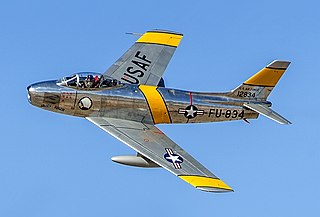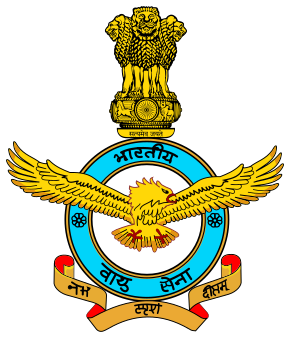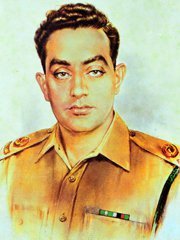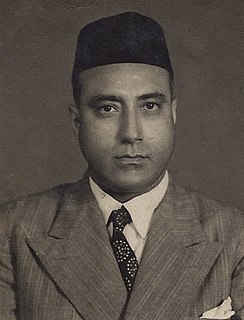Related Research Articles

The Pakistan Armed Forces are the military forces of Pakistan. It is the world's sixth-largest military measured by active military personnel and consist of three formally uniformed services—the Army, Navy, and the Air Force, which are backed by various constitutionally−sanctioned paramilitary forces. According to Global Firepower, the Pakistan Armed Forces are ranked as the 9th most powerful military in the world. A critical component to the armed forces' structure is the Strategic Plans Division Force, which is responsible for the maintenance and safeguarding of Pakistan's tactical and strategic nuclear weapons stockpile and assets. The President of Pakistan is the Commander-in-Chief of the Pakistan Armed Forces and the chain of command is organized under the Chairman of the Joint Chiefs of Staff Committee (JCSC) alongside the respective Chiefs of staffs of the Army, Navy, and Air Force. All branches are systemically coordinated during joint operations and missions under the Joint Staff Headquarters (JSHQ).
The Jammu and Kashmir Instrument of Accession is a legal document executed by Maharaja Hari Singh, ruler of the princely state of Jammu and Kashmir, on 26 October 1947.

Lt. General Ziaur RahmanHJ, was a Bangladeshi military officer and politician who served as the President of Bangladesh from 1977 to 1981. He was assassinated on 30 May 1981 in Chittagong in an army coup d'état.

The North American F-86 Sabre, sometimes called the Sabrejet, is a transonic jet fighter aircraft. Produced by North American Aviation, the Sabre is best known as the United States' first swept-wing fighter that could counter the swept-wing Soviet MiG-15 in high-speed dogfights in the skies of the Korean War (1950–1953), fighting some of the earliest jet-to-jet battles in history. Considered one of the best and most important fighter aircraft in that war, the F-86 is also rated highly in comparison with fighters of other eras. Although it was developed in the late 1940s and was outdated by the end of the 1950s, the Sabre proved versatile and adaptable and continued as a front-line fighter in numerous air forces.

The Indian Air Force (IAF) is the air arm of the Indian Armed Forces. Its complement of personnel and aircraft assets ranks third amongst the air forces of the world. Its primary mission is to secure Indian airspace and to conduct aerial warfare during armed conflict. It was officially established on 8 October 1932 as an auxiliary air force of the British Empire which honoured India's aviation service during World War II with the prefix Royal. After India gained independence from United Kingdom in 1947, the name Royal Indian Air Force was kept and served in the name of Dominion of India. With the government's transition to a Republic in 1950, the prefix Royal was removed.

The Indo-Pakistani War of 1971 was a military confrontation between India and Pakistan that occurred during the Bangladesh Liberation War in East Pakistan from 3 December 1971 until the Pakistani capitulation in Dhaka on 16 December 1971. The war began with Pakistan's Operation Chengiz Khan which was preemptive aerial strikes on 11 Indian air stations, which led to the commencement of hostilities with Pakistan and Indian entry into the war for independence in East Pakistan on the side of Bengali nationalist forces, expanding the existing conflict with Indian and Pakistani forces engaging on both eastern and western fronts. Thirteen days after the war started, India achieved a clear upper hand, the Eastern Command of the Pakistan military signed the instrument of surrender on 16 December 1971 in Dhaka, marking the formation of East Pakistan as the new nation of Bangladesh. Approximately 93,000 Pakistani servicemen were taken prisoner by the Indian Army, which included 65,000 to 81,000 uniformed personnel of the Pakistan Armed Forces, including some Bengali soldiers who had remained loyal to Pakistan. The remaining 12,500 to 28,000 prisoners were civilians, either family members of the military personnel or collaborators (Razakars).

The Indo-Pakistani War of 1947–1948, or the First Kashmir War, was a war fought between India and Pakistan over the princely state of Jammu and Kashmir from 1947 to 1948. It was the first of four Indo-Pakistani wars that was fought between the two newly independent nations. Pakistan precipitated the war a few weeks after its independence by launching tribal lashkar (militias) from Waziristan, in an effort to capture Kashmir and to preempt the possibility of its ruler joining India. The inconclusive result of the war still affects the geopolitics of both countries.

The Indo-Pakistani War of 1965 or the Second Kashmir War was a culmination of skirmishes that took place between April 1965 and September 1965 between Pakistan and India. The conflict began following Pakistan's Operation Gibraltar, which was designed to infiltrate forces into Jammu and Kashmir to precipitate an insurgency against Indian rule. It became the immediate cause of the war. The seventeen-day war caused thousands of casualties on both sides and witnessed the largest engagement of armored vehicles and the largest tank battle since World War II. Hostilities between the two countries ended after a ceasefire was declared through UNSC Resolution 211 following a diplomatic intervention by the Soviet Union and the United States, and the subsequent issuance of the Tashkent Declaration. Much of the war was fought by the countries' land forces in Kashmir and along the border between India and Pakistan. This war saw the largest amassing of troops in Kashmir since the Partition of India in 1947, a number that was overshadowed only during the 2001–2002 military standoff between India and Pakistan. Most of the battles were fought by opposing infantry and armoured units, with substantial backing from air forces, and naval operations.

The Bangladesh Liberation War was a revolution and armed conflict sparked by the rise of the Bengali nationalist and self-determination movement in East Pakistan, which resulted in the independence of Bangladesh. The war began when the Pakistani military junta based in West Pakistan—under the orders of Yahya Khan—launched Operation Searchlight against the people of East Pakistan on the night of 25 March 1971, initiating the Bangladesh genocide.

Major Raja Aziz Bhatti born as Aziz Ahmad but usually known as Raja Aziz Bhatti, was a Pakistan Army officer. He was awarded the Nishan-e-Haider(Eng. Lit.: Emblem of Lion) for his actions of valour during the Battle of Burki in the Indo-Pakistani War of 1965.

Ram Chandra Kak was the prime minister of Jammu and Kashmir during 1945–1947. One of the very few Kashmiri Pandits to ever hold that post, Kak had the intractable job of navigating the troubled waters of the transfer of power from British Raj to the independent dominions of India and Pakistan. He handled the activism of the state's political parties, the National Conference and Muslim Conference, and warded off pressure from the new dominions for the accession of the state. He advised the Maharaja to stay independent for at least a year before making the final decision. His actions were highly unpopular with the state's activist Muslims, and he was dismissed from the post of prime minister shortly before the independence of India and Pakistan in August 1947.

The Pakistan Army is the land service branch of the Pakistan Armed Forces. The roots of its modern existence trace back to the British Indian Army that ceased to exist following the Partition of British India, which occurred as a result of the 1947 Indian Independence Act of the United Kingdom. According to statistics provided by the International Institute for Strategic Studies (IISS) in 2021, the Pakistan Army has approximately 560,000 active-duty personnel, supported by the Army Reserve and National Guard. Pakistani citizens can enlist for voluntary military service upon reaching 16 years of age, but cannot be deployed for combat until the age of 18 in accordance with the Constitution of Pakistan.
Field Marshal is a five–star general officer rank and the highest attainable rank in the Indian Army. Field Marshal is ranked immediately above general, but not exercised in the regular army structure. It is a largely ceremonial or wartime rank, having been awarded only twice. A Field Marshal’s insignia consists of the national emblem over a crossed baton and sabre in a lotus blossom wreath.
The following is a timeline of the Kashmir conflict, a territorial conflict between India, Pakistan and, to a lesser degree, China. India and Pakistan have been involved in four wars and several border skirmishes over the issue.

Major General Janak Singh CIE, OBI, was an officer of the Jammu and Kashmir State Forces in the princely state of Jammu and Kashmir. After retirement, he briefly served as the prime minister of the state during a crucial period in 1947, which was evidently a temporary appointment while the Maharaja looked for a more permanent candidate.

From 1947 to 1956, the Dominion of Pakistan was a self-governing country within the Commonwealth of Nations that shared a monarch with the United Kingdom and the other Dominions of the Commonwealth. The monarch's constitutional roles in Pakistan were mostly delegated to a vice-regal representative, the governor-general of Pakistan.

In Spring 1947, an uprising against the Maharaja Hari Singh of Jammu and Kashmir broke out in the Poonch jagir, an area bordering the Rawalpindi district of West Punjab and the Hazara district of the North-West Frontier Province in the future Pakistan. The leader of the rebellion, Sardar Muhammad Ibrahim Khan, escaped to Lahore by the end of August 1947 and persuaded the Pakistani authorities to back the rebellion. In addition to the backing, Prime Minister Liaquat Ali Khan authorised an invasion of the state, by the ex-Indian National Army personnel in the south and a force led by Major Khurshid Anwar in the north. These invasions eventually led to the First Kashmir War fought between India and Pakistan, and the formation of Pakistan administered Kashmir. The Poonch jagir has since been divided across Kashmir, administered by Pakistan and the state of Jammu and Kashmir, administered by India.

Brigadier Muhammad Aslam Khan (1918–1994) was a Pakistani military officer, who led the Gilgit Scouts and Azad rebels in the First Kashmir War. Using the nom de guerre of 'Colonel Pasha', he organised a force of 1200 rebels and local recruits in Gilgit, and led an attack on the Indian Army and the State Forces from the north, conquering Skardu and Kargil and advancing within 30 miles of Leh. Even though the Indian Army eventually repulsed the attack beyond Kargil, Skardu remained part of the rebel territory, coming under Pakistani control at the end of the war.
Pakistan Army Act, 1952 is the primary statute governing the affairs of Pakistan Army. It was passed by the Parliament of Pakistan in 1952.
Pakistan Navy Ordinance, 1961 is the primary statute governing the administration and discipline of the Pakistan Navy.
References
- 1 2 "The Pakistan Air Force Act, 1953", nasirlawsite.com, retrieved 4 January 2020
- 1 2 Jha 2016.
- 1 2 Blood 1996.
- 1 2 Duxbury & Groves 2016.